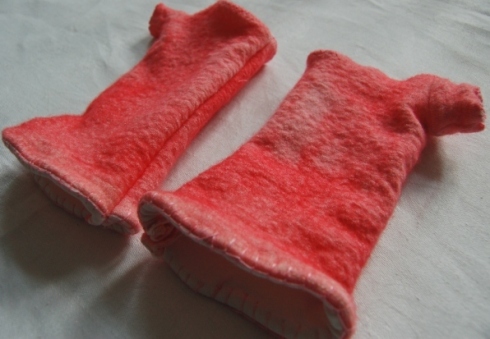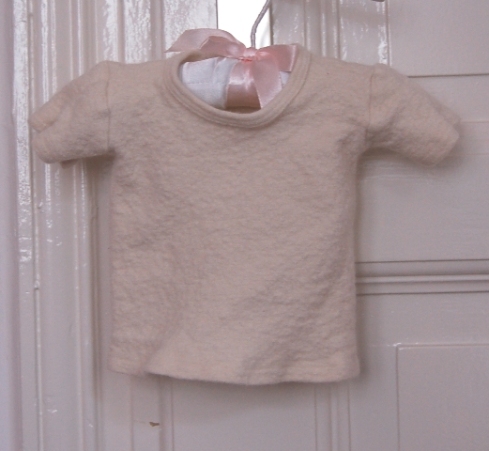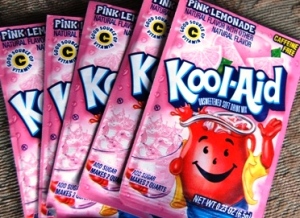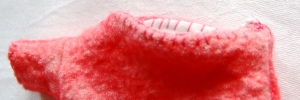
These hand warmers began life as perhaps the most expensive children’s underclothes known to man.
Figuring out the right gear for the weather in Germany has been an ongoing education. When my three-year-old’s kind, dear kindergarten teacher told me he needed undershirts, I listened. He needed not just any undershirts, mind you, but silk-wool undershirts, from a boutique. I can’t even bear to tell you how much I paid for them.
Meanwhile, it’s very un-German of me, but I haven’t been able to kick the big ol’ energy-wasting American dryer addiction. Maybe there’s a 12-step program I can enroll in and by the time we leave here I’ll have cleaned up my act. Dryers do exist in Germany, but it’s much more common, regardless of income level, to use a drying rack. I do this some but not enough.
Sadly, this is what happened to one of the costly silk-wool undershirts:

Gasp! All those Euros gone to waste! I couldn’t handle it becoming just a doll shirt, and my daughter had been asking for a set of hand warmers. So I broke out the Kool-Aid (brought from the U.S.) and dyed it, using roughly these instructions.

If I had it to do over, I’d probably use one less packet of Kool-Aid to get a slightly lighter color, but oh well. It’s done. After that I just cut up the middle of the shirt and trimmed the top down so that the arm-piece of the shirt became the thumb-piece of the warmers.
I used an old T-shirt to line the arm warmers and finished them off with blanket stitching. Voila! You could certainly make a similar pair with a shrunken sweater, using the underarm corner as the under-thumb corner.






![]()

Want to try dyeing things but don’t know where to start?
A reader wrote me recently asking for help.
Where to start, what to read?
The easiest kind of dyeing to start with is food dye on animal fibers. I love this because you can do it in the kitchen with grocery-store items, the results are super-satisfying, and the kids can join in.
What are animal fibers? Wool, silk, cashmere, you get the idea
Wool and Cashmere:
You can do some beautiful things with Kool-Aid and wool, and IT WILL NEVER WASH OUT.
Kool-Aid (or Easter egg dye) and wool yarn is a perfect starter project, especially if you knit. You can dye it with a rainbow of colors, using your microwave. Check out this article for details. Lion Brand makes an undyed 100% wool yarn called Fisherman’s Yarn that is very reasonably priced. I used to buy it at Hobby Lobby, but it may also be available at Michael’s and other craft stores. Knitpicks also sells undyed yarn, in a wider variety of weights and variations. Their prices are very reasonable also, but you do have to order it. Also try dharmatrading.
You can dye pieces of old wool or cashmere sweaters in a similar way, but it’s a little tricky—-you should be prepared for uneven results. Here’s a project of mine with Easter egg dye on cashmere. I would recommend starting with a light-colored sweater and dyeing smaller pieces (an arm or less) at a time, as a sweater acts like a sponge to the dye, absorbing the color before it gets the chance to circulate around the fabric.
The process is similar to the yarn-dyeing project, but use a larger amount of dye and a larger container, on the stove instead of the microwave. I used my big soup pot. The same process should work for wool and cashmere wovens, though I’ve never tried it.
Silk:
Kool-Aid, Easter egg dye, or food coloring also works well on silk. I’ve used it to make playsilks, with the directions here. I’ve also dip-dyed silk scarves, which you can see here. After heat-setting, these dyes are not quite as colorfast as in wool and cashmere, so I would recommend hand-washing, but the bleeding is very little. Also, dry out of direct sunlight.
With any dyeing project, there’s a certain amount of risk involved. You never know exactly what your finished project is going to look like, and for me, that’s part of the thrill. Be prepared for that uncertainty, because even if your project turns out beautifully, chances are it won’t be exactly as you envisioned.
More about other kinds of dyeing soon.

 1 Comments on Getting Started with Dyes, Part I: Animal Fibers, last added: 1/14/2011
1 Comments on Getting Started with Dyes, Part I: Animal Fibers, last added: 1/14/2011








Are you perhaps considering taking over Heloise’s place on the Internet?
GD Bob
Laugh out loud!
I should say, LOL when I saw the shrunken shirt but I suppose it wasn’t funny at all. I like how you rescued your dilemma with a sense of humor and by recycling.
I love hearing how you are making these attitude and lifestyle adjustments.
So glad to make you laugh and don’t worry I can laugh about it now too now that I have at least made soemthing useful out of the mess.